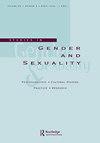Discussion of “Phantom Penis: Extrapolating Neuroscience and Employing Imagination for Trans Male Embodiment”
Q3 Social Sciences
引用次数: 1
Abstract
ABSTRACT As described by Straayer, the phantom penis in transgender men combines feelings of loss and potential and may contribute to self-authentication and pleasure following phalloplasty. To align their gender identity with their body, some transgender men choose to undergo a phalloplasty procedure. For the reconstructive surgeon, the goals of phalloplasty typically are summed as an aesthetically pleasing, sensate phallus with both tactile and erogenous sensation that is capable of standing micturition and penetrative intercourse. Many surgical techniques for phalloplasty have been described, with the radial forearm free flap being the most commonly used. To optimize erogenous sensation, nerve coaptation to the dorsal clitoral nerve in conjunction with burying the denuded clitoris at the base of the neophallus is often performed. While surgical technique contributes to sensory recovery, there is likely a complex interplay between physiology, anatomy, endocrinology, and psychology as they pertain to orgasm and sexuality following phalloplasty. The reconstructive surgeon should engage in a shared decision-making approach with their patient and attempt to optimize aesthetic and sensory outcomes in order to facilitate sexual function following surgery.“幻影阴茎:神经科学的外推和对跨性别男性化身的想象”的讨论
摘要正如Straayer所描述的,变性男性的幻影阴茎结合了失落感和潜力,可能有助于阴茎成形术后的自我认证和快感。为了使自己的性别认同与身体保持一致,一些变性男性选择接受阴茎成形术。对于重建外科医生来说,阴茎成形术的目标通常被总结为一种美观、有感觉的阴茎,具有触觉和性感,能够站立排尿和性交。已经描述了许多阴茎成形术的手术技术,其中前臂桡侧游离皮瓣是最常用的。为了优化性感,通常会将神经与阴蒂背神经接合,并将裸露的阴蒂埋在新阴茎的底部。虽然手术技术有助于感觉恢复,但生理学、解剖学、内分泌学和心理学之间可能存在复杂的相互作用,因为它们与阴茎成形术后的性高潮和性行为有关。重建外科医生应与患者共同决策,并尝试优化美学和感官结果,以促进手术后的性功能。
本文章由计算机程序翻译,如有差异,请以英文原文为准。
求助全文
约1分钟内获得全文
求助全文
来源期刊

Studies in Gender and Sexuality
Social Sciences-Gender Studies
CiteScore
0.80
自引率
0.00%
发文量
15
期刊介绍:
Beginning in the final two decades of the 20th century, the study of gender and sexuality has been revived from a variety of directions: the traditions of feminist scholarship, postclassical and postmodern psychoanalytic theory, developmental research, and cultural studies have all contributed to renewed fascination with those powerfully formative aspects of subjectivity that fall within the rubric of "gender" and "sexuality." Clinicians, for their part, have returned to gender and sexuality with heightened sensitivity to the role of these constructs in the treatment situation, including the richly variegated ways in which assumptions about gender and sexuality enter into our understandings of "normality" and "pathology."
 求助内容:
求助内容: 应助结果提醒方式:
应助结果提醒方式:


